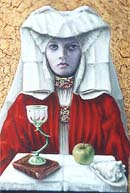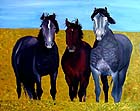As a water based medium they combine well with watercolors and
some Watercolour Groups are starting to accept acrylic paints into their
curriculum.
1901
Main study of acrylic by Rohm.
1915
Patent taken out by Rohm.
1931
The first acrylic product to be used in volume was poly (methyl methacrylate)
better known by its trade names perspex in the UK and plexiglas in America which
was used as a glass replacement in the aircraft of World War II.
1949
An initial range of acrylic paints to be marketed was called Magna by Leonard
Bocour who later formed Bocour Artists Colors Inc. in America. They were sold in
solution form dissovled with turpentine and could be mixed with oil paints.
Moris Louis, Kenneth Noland, Mark Rothko, Robert Motherwell, Barnett Newman and
Roy Lictenstien were associated with using these paints.
1953
The first true acrylic paints were introduced by Rohm and Haas. An emulsion
formula called Rhoplex AC-33 was marketed as an interior wall paint.
1955
Permanent Pigments develop the first commercially available water-based acrylic
paint called Liquitex (Liquid Texture) and in the same year also develop the
first water-based varnish, matte medium, acrylic gesso and modelling paste.
1963
Liquitex became widely available in tubes and at a much thicker consistency.
many prominent artists began to experiment. These included Helen Frankenthaler,
Andy Warhol, and Robert Motherwell in the U>S> and slightly later Bridget
Riley and David Hockney in the U.K..
1970
The first machine to test paint for lightfastness is developed.
1971
Winsor and Newton, U.K. produce paints and a range of related products.
1980
Golden Paints Inc. U.S.A. launch a range of acrylic paints.
1984
Liquitex paints are the first to be labelled for ASTM standards, for toxicity,
quality and lightfastness. The company then goes on to test all acrylic paint in
the art materials industry.
1986
Liquitex develop Interference acrylic paints.
1989
Liquitex develop an Iridescent tinting medium.
1991
Liquitex develop the first acrylic enamel paints call Glossies.
1994
Liquitex develop the first three dimensional, non- leveling, polyurathane paint
called 'Structural'.
2000
ColART acquires Liquitex.
10 Tips for Acrylic Painting
Acrylics are extremely versatile, fast drying, and can be used straight from
the tube like oils or thinned with water or a medium and used like watercolours.
The fact that acrylic paints dry very fast means that you cannot put a lot of
paint on an ordinary acrylic paint palette as it'll most likely dry out before
you've finished. Various art supply companies have produced moisture-retaining
acrylic palettes to solve this problem. Here are a few tips to help you get
started painting with acrylics.
Tip 1: Keeping acrylic paints workable
Because acrylics dry so fast, squeeze only a little paint out of a tube. If
you're using a 'normal' plastic palette invest in a spray bottle so you can
spray a fine mist over the paint regularly to keep it moist. 'Stay-wet' palettes
- where the paint sits on a sheet of wax paper place on top of a damp piece of
watercolour paper - eliminate the need to do this, but generally don't have a
hole for your thumb so are more awkward to hold in your hand.
Tip 2: Blot your brushes
Keep a piece of paper towel or cloth next to your water jar and get into the
habit of wiping your brushes on it after you rise them. This prevents water
drops running down the ferrule and onto your painting, making blotches.
Tip 3: Opaque or transparent
If applied thickly - either straight from the tube or with very little water
added - or if mixed with a little white, all acrylic colours can be opaque. If
diluted, they can be used like watercolours or for airbrushing.
Tip 4: Acrylic vs watercolour washes
When an acrylic wash dries, it's permanent and, unlike a watercolour wash, is
insoluble and can be over-painted without fear of disturbing the existing wash.
The colours of subsequent washes mix optically with the earlier ones. A
watercolour glaze can be lifted out using water and a cloth.
Tip 5: Think thin when thinking glazes
If you want transparent, watercolour-like glazes, these should be built up in
thin layers; a heavy layer will produce a glossy surface.
Tip 6: Improve flow without losing colour
To increase the flow of a colour with minimal loss of colour strength, use
flow-improver medium rather than just water.
Tip 7: Blending acrylic paints
Because acrylics dry rapidly, you need to work fast if you wish to blend colours.
If you're working on paper, dampening the paper will increase your working time.
Tip 8: Hard edges
Masking tape can be put onto and removed from dried acrylic paint without
damaging an existing layer. This makes it easy to produce a hard or sharp edge.
Make sure the edges of the tape are stuck down firmly and don't paint too
thickly on the edges, otherwise you won't get a clean line when you lift it.
Tip 9: Washing-up liquid with masking fluid
Masking fluid can be used with acrylics washes, as well as watercolours. Once
masking fluid has dried in a brush, it's nearly impossible to remove. Dipping a
brush into some washing-up liquid first makes it easier to wash masking fluid
out of a brush.
Tip 10: Using acrylic paint as a glue for collage
Provided it's used fairly thickly and the item to be stuck isn't too heavy,
acrylic paint will work as a glue in a collage.
Parastoo Ganjei
Parastoo Ganjei granddaughter of one of the greatest painters in Iran, has been
living in England since 1977. She received her BA from the University of
Decorative Arts in Tehran and studied animation, graphic design and illustration
in England.
There is a fine reconciliation between opposites in Parastoo's paintings and she
tries to lose the gap caused by the brief impression and lasting expression.
Parastoo paints her objects at an angle that suggests she is looking from high
up. This way of looking at objects gives her a different approach to what she
sees and maintains a sense of planes. Her individual elements placed
three-dimensional on a flat background, have a distinct substance with their
shadows. This creates a tension between realism and abstraction. The strong
opposition expressed by three-dimensional reality to decorative abstraction is
what she likes to achieve in her paintings. Parastoo rates expression above
impression and decoration above realism and creates a nostalgic view of the most
ordinary objects around us. She is a representational painter, and believes in
enjoying paintings that evoke our previous experiences, emotions and feelings,
which are easily recognisable to us. She likes to insinuate the nostalgic
feeling of purity, simplicity, happiness, victory and unity through her works.
Parastoo's paintings have attracted private collectors from around the world and
have been shown in numerous exhibitions in UK. Parastoo Ganjei is a member of
the National Acrylic
Painters' Association.
Mike Fenner
Award winning artist Mike Fenner is one of the founder members of the National
Acrylic Painters' Association. He has exhibited regularly with NAPA, and has
taken part in other group exhibitions both in the UK and abroad. He has also had
several Solo Exhibitions, at the Williamson Art Gallery, Hanover Art Gallery
(Liverpool), and the Durham University Gallery.
Mike works exclusively in acrylics and has won several awards for his
application of acrylics to gain the effect of older oil techniques.
His interests in painting are working figuratively in a style, which combines
early Renaissance techniques with symbolic and iconic overtones. Currently Mike
is exploring Breton mythology as a basis for subject matter, particularly the
myth of "Dahud" and the island of Ys.
"...I believe in the truth of myth and its continuing relevance; the power
of symbol-ideas; underlying the fleeting external objective world, there is the
substratum of history, mysticism, and the collective unconscious. To integrate
these elements is the aim of my work."
Mike Fenner 1998. Mike Fenner is a member of the National
Acrylic Painters' Association.
Joe Ray Kelley
Statement of Artist
"Art makes it possible to communicate with all people without words. I find
beauty in visually expressed emotions of living. In painting people, I make
every effort to capture the facial features that viewers can clearly identify
with and relate to: eyes that silently speak volumes along with facial
expressions and gestures that reflect mood, temperament and intimacy. If
unknown, I speculate about the past, present, and future of the subject being
painted. From the initial planning of a new painting to the final brush stroke,
I receive tremendous gratification and pleasure."
Joe Ray Kelley, a native of Missouri, U.S.A. has been well represented in the
art arena throughout the Mid-West; his work has been accepted and rewarded in
many regional, national and international juried art shows and exhibitions.
Largely, a self-taught artist, Joe's paintings exude a profound understanding of
the interplay of light and subject; his commanding use of color truly focuses
and enhances the viewers' experience of mood and intimacy.
Joe is a member of many artisan organizations, including: the National Oil and
Acrylic Painters' Society NOAPS), Joe Ray is Registrar for the NOAPS Signature
Artist Guild,the Kansas City Artists Coalition and the Greater Kansas City
Artist Association. Gallery membership and representation have included: Agora
Gallery, SOHO in New York City, New York, the Northland Exposure Artists'
Gallery in Parkville, Missouri, the Period Gallery in Omaha, Nebraska and
Wishing Spring Gallery, Bella Vista, Arkansas.
In addition, Joe Kelley has been recognized in the fine art field and was the
honored recipient of The Director's Award at "The Second International
Spiritual Exhibit" held at the Period Gallery in Omaha, Nebraska to
highlight one among many other prestigious awards and recognitions.
Many buyers, domestic and abroad, have selected Joe Kelley's art to proudly hang
in homes and corporate offices from Galway Bay, Ireland to Monterey Bay,
California to Hong Kong, China.
He has traveled extensively and visited many galleries and museums (including St
Petersburg Russia, Paris, Toledo Spain, Dublin Ireland, New York, Carmel,CA and
Chicago) to study art. To visit Joe Ray Kelley' website click
here.
.
 Berabus
Berabus
 R. Charboneau
R. Charboneau
 Artist Number 3
Artist Number 3
 Artist Number 4
Artist Number 4
 Artist Number 5
Artist Number 5
 Artist Number 6
Artist Number 6
 Artist Number 7
Artist Number 7
 Artist Number 8
Artist Number 8
 Artist Number 9
Artist Number 9
 Artist Number10
Artist Number10











